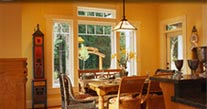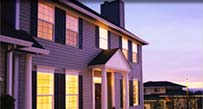Coated Glass: Which type of coating will keep you warmer?
Source Post: http://www.replacement-windows.com/windowbb/viewtopic.php?p=5486Great topic!
FenEx is 100% correct that soft coats must be protected so they are only available when sealed in an IGU. And, as ColoJ pointed out, hardcoats are basically tin oxide that was applied to the upper surface of the glass during the float process so that they don't need the same level of protection as does a softcoat.
Float glass is called such because it literally floats on a bed of molten tin during the manufacturing process. This leaves a microscopically-thin layer of tin on the bottom layer of the glass - hence the terms "air-side" and "tin-side" which applies to all glass manufactured in the float process.
The consumer (or window company for that matter) can't really tell one side from the other, and from a window performance stand-point, it doesn't matter a bit.
But, it does matter to the folks who coat glass. Softcoats consist of multiple layers of metals and metallic oxides that are "sputtered" on to the air surface of the raw glass. Note air-side. As mentioned, hard-coats are tin oxide applied to the upper surface of the glass during the float process. Soft-coats simply work better at blocking UV and at blocking both longwave and shortwave IR than do hardcoats.
But, that certainly doesn't mean that hardcoats have no value...and, the hardcoat manufacturers are constantly working hard to come up with product that meets the standards of the soft-coat world.
The ironic thing is that while the hardcoat guys advertise that their lower SHGC numbers are an advantage in heating-dominated climates, they are also advertising how they are working to "improve" their SHGC numbers (not generally in the same publications at the same time, however). Wink
Canada does use solar heat gain as a calculation in their energy performance numbers. Never mind that the numbers used in that particular calculation were actually developed by the hardcoat manufacturers...of course R-factor was originally introduced by fiberglass insulation manufacturers...which coincidently happens to be some of the same companies. Wink
Obviously passive solar heating does have both real and imaginary advantages over the alternative. Heck, I really enjoy the feel of the sun, thru clear glass, warming me in the middle of the winter. There's a great feeling when you get into your car on a cold, sunny, winter day.
Unfortunately, as soon as a cloud passes between the sun and that glass then that feeling goes away really quickly - to be replaced by a sudden chill as that warmth is sucked back thru the window in the other direction. Thus the need for a LowE coating.
ColoJ, you have a pretty good idea of how much heat you gain via the solarium. You don't know how much you lose (measurable BTU's), but you do know that the 80-90 degree daytime temp in the solarium drops to freezing or so at night?
I think I would recommend a log measuring temperature changes and conditions...for example, " 1/19/06 - noon, heavy clouds, temp in the solarium is 65 degrees"...or, " 1-29-06, 2:pm clear and sunny, temp 93 degrees". I think that this would allow you to chart the temperature changes versus conditions and with charted data you could calculate the potential gain and loss advantages of various LowE coatings and even clear glass - in the solarium - and that would allow a calculation of payback versus the cost of the various options.
An even better way (but more expensive) would be to invest in an electronic thermometer with charting capabilities...then you would really know what is happening in there.
The idea of a "LowE" blind is technically correct, but kind of misleading in my opinion. Emissivity is the inverse of reflectance. ALL blinds or shades are by definition low emissivity in that they block something, but by adding a layer of reflective material to the surface of the blind you increase reflectance and subsequently decrease emissivity ¦of course if the window had a LowE coating already, then you could set up something of a hot space between the blind and the window and that can lead to all sorts of interesting issues.
o while the customer service person is technically correct in saying that the blinds are low emissivity it is at the cost of things like visible light and the view out the window. Heck, aluminum foil makes for great low emissivity numbers when used to cover a window!
Source Post: Who still makes high solar heat gain windows?
http://www.replacement-windows.com/windowbb/viewtopic.php?p=5486
Posted: Thu Jan 19, 2006 8:24 am




 Call us at
Call us at


